December 18, 2009
Intentionality In Treatment
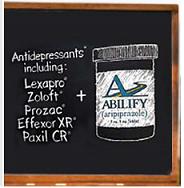
the Abilify was supposed to improve your symptoms but you got better anyway
As a follow up to advice in psychiatry.
Intentionality in treatment matters, and it is conveyed in subtle ways.
In an experiment, a subject could be put through a electric shock experiment, or a auditory tone experiment, as chosen by a second subject. However, sometimes this choice was reversed by a computer, and the resultant switch was revealed to the subject. In other words, he would see on the computer "Subject B chose to give you tones; however, you will receive shocks."
In this way, Subject A would think Subject B intentionally gave him shocks, or unintentionally.
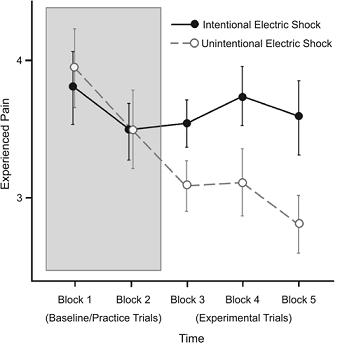
Intentionality in treatment matters, and it is conveyed in subtle ways.
In an experiment, a subject could be put through a electric shock experiment, or a auditory tone experiment, as chosen by a second subject. However, sometimes this choice was reversed by a computer, and the resultant switch was revealed to the subject. In other words, he would see on the computer "Subject B chose to give you tones; however, you will receive shocks."
In this way, Subject A would think Subject B intentionally gave him shocks, or unintentionally.

You can see that the subjects experienced the pain as more severe when they thought it was on purpose. However, look carefully, you see something else: when it's by accident, they got used to the pain. When it was on purpose, they didn't get used to it.
II.
Cognitive reframing can be used everywhere.
There are plenty of examples related to pain, but it's better if this can be applied more generally. When things are bad, is there a way to experience them as less bad? Instead of studying something as vague as "sadness" or "anxiety" let's look at something concrete: losing money.
When subjects were given $30 to gamble (max win $572, max loss $30) subjects were measured on how loss averse they were:
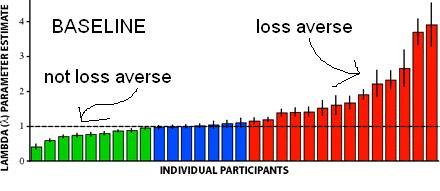 Then these same subjects were given a cognitive reframing: "pretend you are a trader" "think like a pro" etc.
Then these same subjects were given a cognitive reframing: "pretend you are a trader" "think like a pro" etc.
This technique reduced loss aversion:
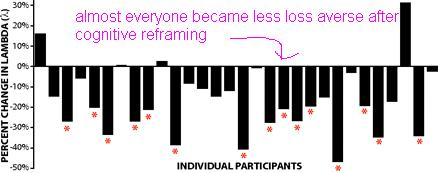 not just subjectively, but even as measured by skin conductance, which measures arousal and sympathetic nervous system activity (similar to lie detector):
not just subjectively, but even as measured by skin conductance, which measures arousal and sympathetic nervous system activity (similar to lie detector):
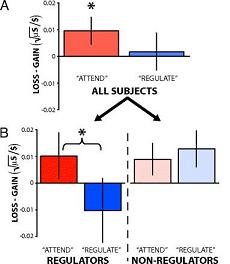
Graph A shows that while people were more aroused (by skin conductance) to losses than to gains ("Attend" is simply gambling without using the reframing trick)-- when given the cognitive reframing (the "Regulate") this arousal disappeared. "Thinking like a trader" neutralized a physical response.
When you tease out the people who are good at reframing (Graph B, the "Regulators") the difference between using the reframing and not using it is even bigger.
Clearly some people are naturally good at this, and others are not; but the technique can be universally tried. The more you practice, the better you'll be.
III.
But the important part of this message is that a person's experience of anything is very much influenced by context, presentation.
Psychiatry has adopted a policy of pulling aside the curtain: letting the patient in on the language usually reserved for practitioners, which is fine, except that it is almost always misunderstood. "Dirty drug," "bipolar", "flip him into mania"-- "augment with Abilify"-- these terms convey information to the patient that is usually not intended-- not to mention being factually empty. They are never corrected, because the psychiatrist has forgotten how to speak in ordinary but still descriptive language.
Every university hospital has a "Treatment Resistant Depression" clinic. However, they are by referral only; a patient can't just call and make an appointment. So why name it that? It's a signal to doctors, "send them here." But it's not a secret signal-- the patient knows what it's called. What message does that send to the patient?
---
http://twitter.com/thelastpsych
II.
Cognitive reframing can be used everywhere.
There are plenty of examples related to pain, but it's better if this can be applied more generally. When things are bad, is there a way to experience them as less bad? Instead of studying something as vague as "sadness" or "anxiety" let's look at something concrete: losing money.
When subjects were given $30 to gamble (max win $572, max loss $30) subjects were measured on how loss averse they were:
 Then these same subjects were given a cognitive reframing: "pretend you are a trader" "think like a pro" etc.
Then these same subjects were given a cognitive reframing: "pretend you are a trader" "think like a pro" etc.This technique reduced loss aversion:
 not just subjectively, but even as measured by skin conductance, which measures arousal and sympathetic nervous system activity (similar to lie detector):
not just subjectively, but even as measured by skin conductance, which measures arousal and sympathetic nervous system activity (similar to lie detector):
Graph A shows that while people were more aroused (by skin conductance) to losses than to gains ("Attend" is simply gambling without using the reframing trick)-- when given the cognitive reframing (the "Regulate") this arousal disappeared. "Thinking like a trader" neutralized a physical response.
When you tease out the people who are good at reframing (Graph B, the "Regulators") the difference between using the reframing and not using it is even bigger.
Clearly some people are naturally good at this, and others are not; but the technique can be universally tried. The more you practice, the better you'll be.
III.
But the important part of this message is that a person's experience of anything is very much influenced by context, presentation.
Psychiatry has adopted a policy of pulling aside the curtain: letting the patient in on the language usually reserved for practitioners, which is fine, except that it is almost always misunderstood. "Dirty drug," "bipolar", "flip him into mania"-- "augment with Abilify"-- these terms convey information to the patient that is usually not intended-- not to mention being factually empty. They are never corrected, because the psychiatrist has forgotten how to speak in ordinary but still descriptive language.
Every university hospital has a "Treatment Resistant Depression" clinic. However, they are by referral only; a patient can't just call and make an appointment. So why name it that? It's a signal to doctors, "send them here." But it's not a secret signal-- the patient knows what it's called. What message does that send to the patient?
---
http://twitter.com/thelastpsych
26 Comments